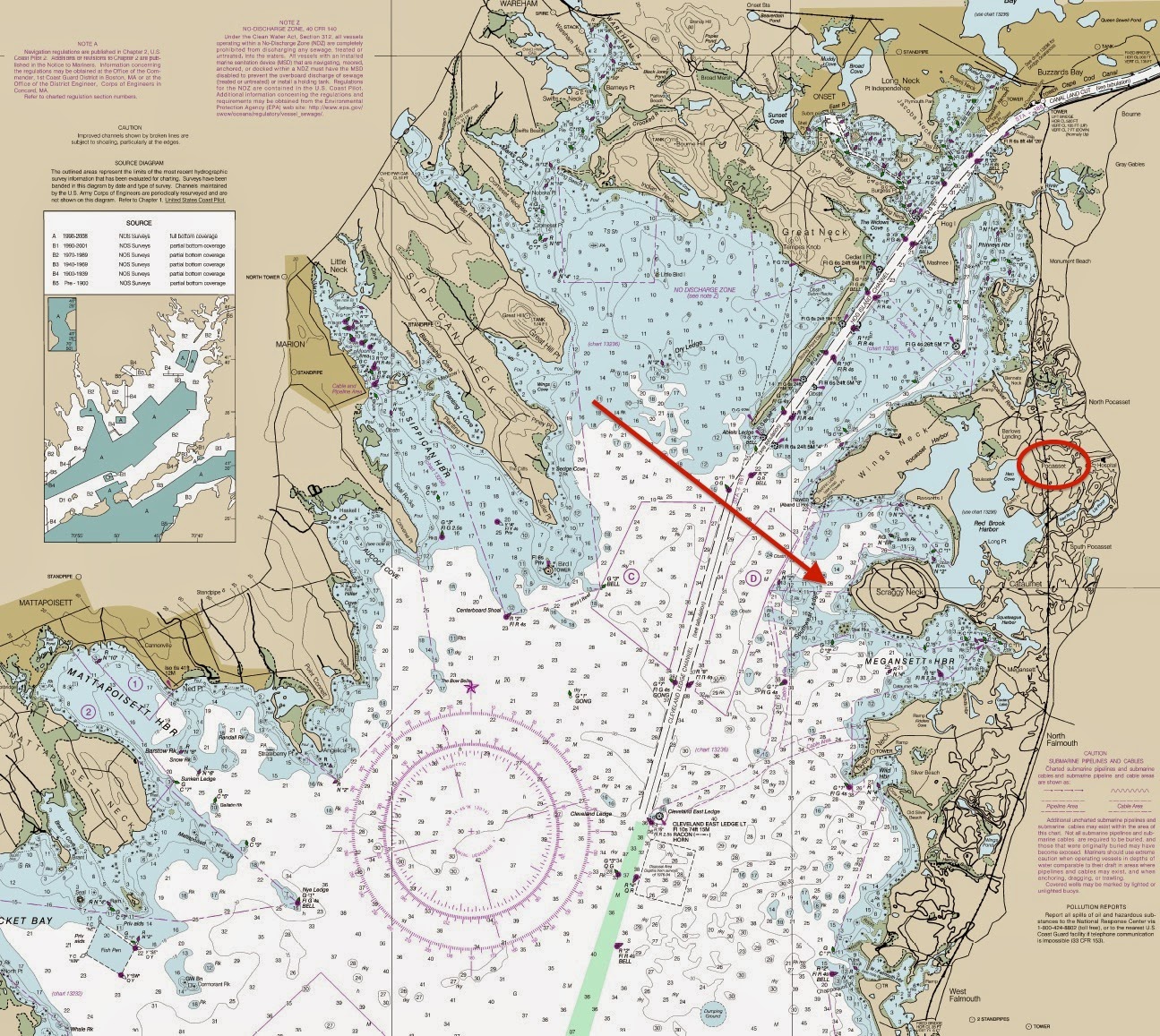This narrative accompanies the Trip Plot posted earlier via the 'Captain's Blog' app
Voyage #23 (Solo #4)
Thursday, 7 Aug 2014
HW 1756: LW1044
Winds: NW 0-6
Waves: 0-2'
17.3 nm
5hr 33min
I headed out at 10:00am on a Thursday morning on my fourth solo sail. I did not really have much of a sail plan in mind: get out on the water and go. It was a sunny day with temperatures in the low 70s. Winds were forecast to be out of the NW 9 knots, gusting to 14, although from the house they seemed light and variable. Just go.
Motoring out to the R6 navigation aid at the mouth of the river, I set the mainsail. All season long I have been having troubles raising the mainsail to its full height. I haul on the halyard and it shoots right up the mast, but its stops about six inches from a black line near the masthead, which I assumed marks the optimal height of deployment. Pull and tug as I might, even with the help of others, I just could not seem to get that sail all the way up to the top of the mast. Consequently, there was a bulge in the sail at its tack, near the point were the boom attaches to the mast.
There is something wrong with this picture.
Try as I might, it just seems impossible to get that last half-foot of sail any farther up the mast.
It meant the sail was operating at less than optimal efficiency (although that was a given anyways, since the sail trim was in my rookie hands). It was not a big deal; I could still sail like that. But it bothered me, and it looked sloppy. Something must be wrong up there near the masthead, I figured, perhaps with the blocks or pulleys through which run the mainsail halyard. But hiring someone to go up there in a bosun's chair was just beyond my budget. I was determined to look at it careful in the winter off-season, but for now I would just have to tough it out.
Then someone suggested that I use the winch on the halyard, pointing out many bigger boats have a winch (or winches) near the companionway, for help with the halyard and a variety of other tasks. So I wrapped two turns of the taunt halyard around the starboard winch and began to grind away with the winch handle. It took some effort, but the sail finally went all the way up!!! I was so elated.
But my smugness quickly turned to anxious concern when I realized that I had failed to "tail" the line properly as I had worked the winch handle: I had not been attentive enough to guide the line as it came around and off the winch, and consequently the line had wrapped over itself on the winch and was now bound up tightly. I was underway, the mainsheet was loose and the mainsail itself just luffing effortless, but I was unable to lower the sail at all. It took some serious pulling before I was able to create enough slack to work the halyard back off the winch, and finally settle down.
Winds were light. Sailing on the northern side of of Sippican Neck, I was making only 2.0 knots with the mainsail. After five minutes, I decided to set the jib as well, but was discouraged to watch my speed drop to 1.2 knots. Ten minutes later I had turned on the motor, determined to get out there one way or the other. Perhaps farther out I might catch a better breeze. It was shortly after low tide, and as I approached the shoal known as "Dry Ledge," I could see the tops of rocks above the calm waters.
Dry Ledge shoal
and Red 2 navigation aid marking the approach to the Wareham River
Having reach the open bay, I shut off the outboard motor and tried sailing with jib and main. Top speed: 0.3 knots. By 11:30, I was sufficiently discouraged to douse both sails and head for home under motor power. But just as I neared the mouth of the rivers, a breeze picked up and I reset both sails, for a while was making 3.5 knots! When the Admiral goes boating, she would prefer to add a digit to that speed, preferably to the right of the three and left of the decimal point. But for me, three-and-a-half knots was just fine.
That's the way she likes it.
"Flying across the waves with nothing in my hand except a cold drink."
Well, you buy that boat, Dear. I bought the sailboat.
Across to the Cape
It took me about an hour to cross from Upper Buzzard's Bay from Butler Point (on the Marion side) to Pocasset (on the Cape), sailing on beam reach most of the way. I was making 5.7 knots by the time I approached Scraggy Neck near Pocasset. Suddenly my marine radio crackled to life with a Severe Thunderstorm Warning for the region, capable of producing nickel-sized hail. Mariners were advised to head for shelter or safe harbor immediately. Whaaaaaaaaaat? There then followed a list of towns in the path of the storm track, all of which were well east of my position. After listening to several repeat broadcasts of this warning, which was quite emphatic, I concluded that the storm did not pose an immediate danger to me. I needn't run for shelter post-haste, but perhaps it would be prudent if I were to turn for home.
By 2:25pm I was back out in the middle of the channel, doing 6.3 knots amid two-foot seas. Then I heard the deep rumble of thunder and looked leeward to see lightning flash across the sky over the Cape Cod Canal, about five or six miles to the northeast.
Thunderstorms over the Cape Cod Canal





No comments:
Post a Comment
I welcome your comments and suggestions....